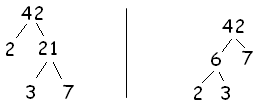Any integer that divides into another integer evenly is a factor. For example, 3 and 2 are factors of 6, 12, 18, etc. The number 16 has 2, 4 and 8 as factors. The number is always a factor of itself. The number one is a factor for all whole numbers.
To quickly find the total list of factors for a given number, start with 1 and the number itself and then work your way up until you start repeating numbers. For example, to factor 36:
1 × 36 = 36
2 × 18 = 36
3 × 12 = 36
4 × 9 = 36
(5 doesn’t work, so skip it)
6 × 6 = 36
And you’re done. Neither 7 nor 8 work and you’ve already got 9. So the list of factors of 36 is:
1, 2, 3, 4, 6, 9, 12, 18, 36
Prime Numbers in Factorization
A special category in factorization is prime numbers. A prime number only has 1 and itself as factors. It is helpful to memorize the following list of prime numbers to recognize them easily:
2, 3, 5, 7, 11, 13, 17, 19, 23, 29, 31, 37, 41, 43, 47, 53, 59…
If you’re stuck, try using the quick division rules to get you through. For example, is 103 a prime number?
It’s odd, so you can rule out 2, 4, 6, and 8.
It doesn’t end in a 5 or 0 so you can rule out 5 and 10.
It isn’t divisible by 3 so you can rule out 3 and 9.
You have to try 7 on its own because there is no rule, but 7 doesn’t work either.
11 × 11 = 121 which is more than 103, so we’re done, and yes, 103 is a prime number.
All prime numbers must be positive because negative numbers have -1 in addition to +1 as a factor. Also, other than 2, all prime numbers are odd, otherwise they would also have 2 as a factor.
The next step to consider is prime factorization. To find the prime factorization of a number, keep finding factors (even if they repeat) until the only factors used are prime. There are two ways to find prime factors: go up in order or do it visually like a family tree.
To illustrate how to go up in order, let’s find the prime factors of 42:
42 ÷ 2 = 21
You cannot divide 21 by 2, so go up to 3.
21 ÷ 3 = 7
7 is a prime number so you’re done. The prime factors for 42 are thus:
42 = 2 × 3 ×7
Here are two examples of the family tree way of doing it:

Either way, you end up with:
42 = 2 × 3 ×7
Finally, the SAT might ask you to find the greatest common factor of two or more numbers. It is also a good trick to know for other types of problems as you will see in other lessons, especially when reducing fractions. The greatest common factor is the largest factor that the two numbers share. It will always be the prime factors that the two numbers have in common – that’s a cool trick to remember.
For example, to find the greatest common factor of 21 and 63, find their prime factorizations:
21= 3 × 7
63 = 9 × 7 = 3 × 3 × 7
What do they have in common? Both prime factorizations have 3 × 7 in common. So the greatest common factor must be 21.
Let’s try harder one. What is the greatest common factor for 92 and 460?
92 = 2 × 46 = 2 × 2 × 23
460 = 2 × 230 = 2 × 2 × 115 = 2 × 2 × 5 × 23
So 2 × 2 × 23 is the greatest common factor, or in this case, 92.

